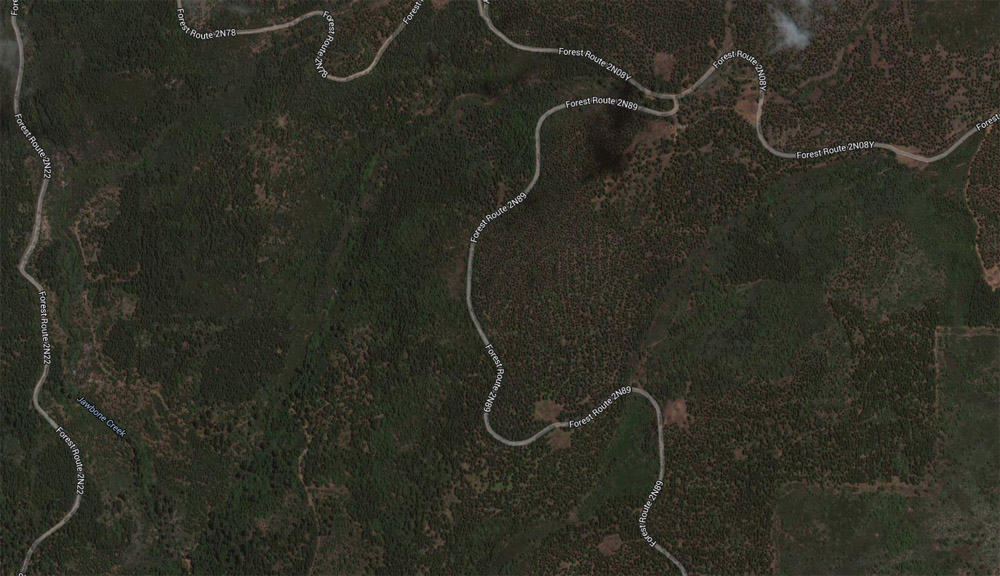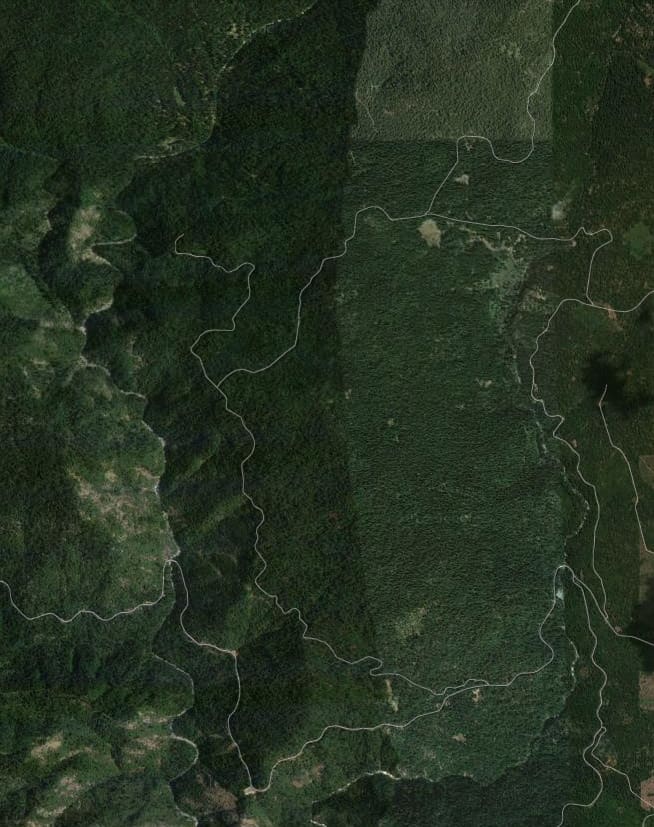Derek tipped me off about the new BAER fire severity maps, yesterday, and I was happy to see that the efforts to thin plantations has resulted in lower fire intensities. Here is the link to both high and low resolution maps. It is not surprising that fire intensities outside of this thinning project I worked on were much higher, and I doubt that there was much survival in the unthinned plantations. Those plantations were the within the 1971 Granite Fire, and is yet another example of forest re-burn. This part of the fire has terrain that is relatively gentle, compared to the rest of the burned areas. To me, it is pretty clear that fuels modifications reduced fire intensities.
This photo below shows a boundary between burn intensities. The area east of road 2N89 was thinned and burned much cooler than the untreated areas to the west. The areas in between the plantations had moderate to high burn intensities, due to the thick manzanita and whitethorn. Those areas were left to “recover on their own”. The SPI lands did not fare as well, as they didn’t thin their plantations.
The highest burn intensities occurred in the old growth, near the Clavey River. Activists have long-cherished the areas around this river, and I am assuming that these were protected as spotted owl/goshawk PACs. As you can see, this area has very thick old growth, and it shows on the map as high intensity. This same scenario is one that Wildlife Biologists have been worrying about for many years, now. These wildlife areas have huge fuel-loading issues and choked understories. Prescribed fires cannot be safely accomplished in such areas, without some sort of fuels modifications. Last year, I worked in one unit (within an owl PAC) on the Eldorado where we were cutting trees between 10″ and 15″ dbh, so that it could be safely burned, within prescription.
Nearly all of the Groveland Ranger District’s old growth is now gone, due to wildfires in the last 50 years. What could we have done differently, in the last 20 years?


Larry: This is an excellent post, and clearly illustrates the potential advantages of fuel management (“logging and prescribed burning”) in forested areas prone to wildfire. Your rhetorical question of “what could we have done better?” is clearly answered by these maps and photographs.
So, a public lands clearcut that was replanted (likely not with site-specific seed-stock) into nothing more than a tree farm plantation was “thinned” and then in this specific case a wildfire didn’t burn the entire former clearcut, turned tree plantation.
So the question “what could we have done better” is clearly answered? Really? Is the answer turning public lands into nothing more than tree plantations?
@Matthew Koehler
I’m seeing that your reading comprehension is failing, Matt. I clearly stated that these plantations were the result of the 1971 Granite Fire. Thanks. Also, my on-site experience says that these plantations were NOT planted with off-site planting stock. Yes, I have seen those kinds of older plantations but, the early 70’s foresters were smarter than you might think, Matt.
The entire plantation thinning project looks like it came through just fine, and it was the brush patches, in between the plantations, that burned more intensely.
@Matthew Koehler
Additionally, in the last 20 years, clearcutting has been banned in the Sierra Nevada National Forests. So, it is obvious that we haven’t been “turning public lands into nothing more than tree plantations”. I guess we could stop planting burned areas but, that doesn’t seem like a good thing, to me. Those gaps between the plantations show the results of not planting burned areas.
@Matthew Koehler
Matthew.. as a person who worked in reforestation in the 70’s with an education in genetics it seems strange that you assume that people did not use the “best science” at the time.
Which links back to the video with the law professors, who assume that there are ways of doing planning better, that FS planners did not know and the assumption that they didn’t talk to community planners (and the assumption that they had better ideas) . But, of course, the Planning Model was developed by very smart and experienced people like John Rupe and Chris Liggett who looked at that literature and worked with community planners.
So this is a question: Why do you assume that reforestation folks, who are trained and hired to do something by the FS, are incompetent? (I’m referring to your comment “likely not with site-specific seedstock”).
thanks for this post, Larry!
@larryharrellfotoware
Matt: I was a reforestation contractor for more than 20 years and personally planted more than 2 million trees, while my crews performed more than 85,000 acres of reforestation contracts between 1970 and 1990 (I started planting in 1966). You are correct about the USFS using off-site seed sources, but that was before WW I. Around 1910 Thornton Munger began research on Douglas-fir genetics for the USFS at Wind River nursery and by WW II “seed zones” had been firmly established and most USFS and private industrial lands were using local seed for their planting projects. There were some exceptions, usually due to efforts to plant unexpectedly large wildfires such as the Tillamook Burn in western Oregon in 1933 – 1951, and the ca. 1966 Sundance Fire in northern Idaho, where I probably planted some off-site seedling myself around that time and in the next few years. But not too many, and none that I know of since 1970 or so. The problem isn’t off-site seed sources, it’s poor planting stock, and (way) too many seedlings per acre in most instances.
Larry
A great post and your personally site related insight. I don’t believe that you nor any other professional here would contend that things will always work out this way. We should also all be in agreement that over the course of all fires, this outcome has a significantly higher probability of occurrence than the same outcome or a worse outcome in plantations versus un-managed natural stands or unthinned plantations.
Matthew
Re: “Is the answer turning public lands into nothing more than tree plantations?”
–> No professional forester here would contend that plantations are THE answer in every situation. But at least we see that site specific management dictates that we have more than one option. Do you realize that tree plantations could even be made up of mixed species where it was appropriate to the site and and especially where it reduced the probability of insect attack?
–> Why would you have no problem with huge fire scars or huge beetle kills while having a big problem with vigorous, vibrant, small, well dispersed plantations intermingled with vibrant managed natural stands? Do you realize that diversity in the form of different age classes is generally more environmentally friendly over the long term than one huge old stand?
I wish we could get our hands on the same BAER imagery…and zoom it up to a decent scale…such as the pre-fire Google Earth image…and overlay it on the Pre-fire Google earth image. Anyone into ESRI ARC/GIS? Certainly the USFS BAER teams have the capability. Seems to me to be the BEST research tool there is for “efficacy of fuels treatments.”
While plantation management is important, the bigger issue is old growth, where endangered species live. When such areas burn at high intensities, those habitats will be gone for a VERY long time. Additionally, some people don’t care if those areas burn, embracing “free range fires” and “whatever happens”. What good is preservation if an ignition incinerates what take centuries (or more) to grow? Again, it really doesn’t matter if the fire was human caused, or a “natural” ignition. The results are very similar.
@larryharrellfotoware
Not much sense to it all is there?
Here is a very good but very long article which includes the following quote “Research by Finney in the last decade indicates that burning or cutting up as little as 30 percent of a forest can, if done strategically, have an outsize effect on limiting a wildfire’s spread”
See: http://www.nytimes.com/2013/09/22/magazine/into-the-wildfire.html?nl=afternoonupdate&emc=edit_au_20130919&_r=0
@Gil DeHuff
My point is that those old growth forests are protected from logging but, not protected from catastrophic wildfires, like the Rim Fire. Opponents of logging don’t seem to care if the entire old growth stand is incinerated. They consider it to be part of the preservation “business”, and not a problem in the “scheme” of all things “natural”, without regard to the excessive damages of such wildfires.
@larryharrellfotoware
I got your point and agree with it completely. We both have repeatedly addressed the logical inconsistencies in the positions taken by many groups. The real problem is that logic is of no interest to such groups. They want what they want and they want it now. “Dam the torpedoes, full speed ahead”
Two very good reports on the RIM fire followup:
“Miller says a fire has not left such a contiguous moonscape in the Sierra since before the Little Ice Age, which began in 1350.”
http://www.sfgate.com/news/science/article/Nearly-40-percent-of-Rim-Fire-land-a-moonscape-4826561.php#!
http://blogs.kqed.org/newsfix/2013/09/19/rim-fire-draft/#!